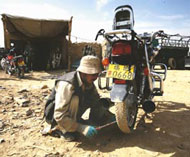
Riding with the Kabul Knights
It had been a big night. As two Australian females who had been in Kabul just a few days, we had jumped at the chance of a big night out and a ride with the little known “Kabul Knights Motorbike Club”.
They offered to show us the real Afghanistan on a five-hour ride up into the Salang Pass. It was an offer too good to refuse, especially as we had promised our families and loved ones we wouldn’t be leaving the city and were going to be living in a walled compound with 24 hour security.
The rallying point was the garden of the rather well-appointed villa occupied by two club members. It was also 7.30am, the time when all the bravado of the night before became a reality.
It seemed like a great idea at the time. Neither of us was saying much, we were looking at the bikes – 150cc Chinese Aktars, upholstered with Afghan rug seating and one with a “666” numberplate (you can choose your own numberplates). They looked great f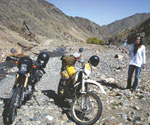 or a bit of a run about the bush, but five hours on the back of one, with a hangover and stories of kidnappings still lurking in the back of our minds; the atmosphere was palpable.
or a bit of a run about the bush, but five hours on the back of one, with a hangover and stories of kidnappings still lurking in the back of our minds; the atmosphere was palpable.
I had been a passenger on a short introductory ride around the city with a driver who was lithe, like a jockey, and fashionably dressed in a body hugging black Prada jacket. He knew from our earlier jaunt that my affinity with motorbikes was about the same as Mr Bean’s. My 15 layers of clothing and headscarf resembling a blanket didn’t help.
When he realised I was again to be his passenger, the atmosphere turned into one of disappointment. I didn’t let it affect me and decided the ride was all part of a thrill-seeking adventure. My comrade, Karin, and I looked more like “queasy” than “easy riders”.
Club members had matching red Chinese helmets and a variety of extras for their passengers. The one they found for me was full-face, bright yellow and obviously designed for someone with a much bigger head, Herman Munster maybe; including the bolts on the side of his neck!
The visor was scratched and tinted; perfect for a Russian Mafia boss with an aversion to daylight. I slipped it over my head and it immediately swivelled round so that everything before me disappeared. That may be a good thing, I thought. Sometimes ignorance is bliss.
The Kabul Knights Motorbike Club ride included four of the 10 members; Travis a photographer and Jeremy a journalist (both Australians) and two rugged looking South Africans who looked as though they would handle themselves well in a rugby scrum.
The two other female passengers were Irish – one working with abused women and the other was “having a P.J. O’Rourke sort of holiday”. Why not? Kabul is the perfect destination for extreme vacations.
A fifth bike was ridden by an extremely handsome Afghan whose passenger was his expat American girlfriend – a relationship conducted somewhat undercover and immediately put at risk when it was discovered that he was the only one without a helmet.
The guards at the compound regarded us with mild amusement as we stumbled about. This changed to polite, stifled hilarity when they heard that our destination 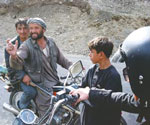 was Salang. The route we were taking had been the setting for some of the most ferocious battles between the Afghans and the occupying Soviet communist army in the eighties.
was Salang. The route we were taking had been the setting for some of the most ferocious battles between the Afghans and the occupying Soviet communist army in the eighties.
The Salang tunnel had been controlled by the Islamist warlord Gulbuddin Hekmatyar, who was one of the most controversial of the Mujahideen leaders. He has been accused of spending more time killing other Mujahideen than Russians during the Soviet war. This didn’t stop him from holding the office of Prime Minister twice in the ’90s. He is also famous for calling in bombs on his own city.
As we wheeled out of the villa gates into the mayhem that is Kabul traffic, I caught an interesting grimace on Karin’s face. She later revealed that the expression was the outward sign of a mild panic attack. Fortunately because of my full-face helmet, my own grimace was hidden behind a dusty visor.
It was a Friday, which in Afghanistan is equivalent to the weekend in Western countries. It’s a day for going to the mosque, playing cricket, visiting families, dog fighting, sheep slaughtering and just generally sauntering about, mainly into the oncoming traffic.
Our first stop was for petrol. Our second was for the first breakdown before we left the city limits. One of our leaders had a flat tyre. We had only been travelling 30 minutes and already I was “saddle sore” and alighted with a sort of John Wayne gait; but wrapped up like the “Michelin” man, I thought I hid it well.
Immediately alongside of us, a yellow vehicle pulled up and about 11 men jumped out. They all ran to the boot of the car and opened it to reveal four legs kicking in the air. They belonged to a fat-tailed sheep that was picked up and dragged bleating across the patch of dirt and swiftly dispatched by the roadside butcher to a better place than the dark boot of a clapped out Toyota Corolla.
Being the only vegetarian in the group, of course I was the only one who witnessed this event. The others were looking at the flat tyre, taking photographs and buying bilani, the fried bread with potatoes and chives that are Afghanistan’s tastiest roadside snack – for a vegetarian anyway.
Men and boys appeared from everywhere with all sorts of advice on how to repair the tyre. After 30 years of war, conducted without much help from the West, improvisation is their forte. I knew they were the guys for the job.
Unfortunately, being a Friday, their focus immediately went elsewhere when they heard the start of the dog fights (a popular sport in Afghanistan, along with camel fighting, partridge fighting, scorpion fighting, dove charming/cutting – you name it), and they disappeared as quickly as they had arrived.
The poor hounds were chained up waiting for their turn in the arena, the “bookies” had already set the prices on the Monday night and money resembling old toilet paper was rapidly changing hands.
With the tyre repaired, we headed out of Kabul and down into the Shamali plains. Grape vines lined in dusty roads. At one time there had been a small but quality wine industry in Afghanistan. Many Afghans love red wine, much like the French, but the Taliban made sure that the wine industry withered on the vine. That’s a shame, because if the wines tasted as good the grapes, they could have been gold medal contenders.
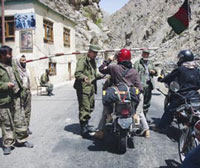 Our first official stop was the town of Charikar, 5200 feet above sea level and a place that has known its share of war. In the 1840s, the British, considered unconquerable and omnipotent fought one of their most ill-advised and disastrous wars in Afghanistan. Their retreat from Kabul dealt a mortal blow to the prestige of the empire that was possibly only equalled by the fall of Singapore 100 years later.
Our first official stop was the town of Charikar, 5200 feet above sea level and a place that has known its share of war. In the 1840s, the British, considered unconquerable and omnipotent fought one of their most ill-advised and disastrous wars in Afghanistan. Their retreat from Kabul dealt a mortal blow to the prestige of the empire that was possibly only equalled by the fall of Singapore 100 years later.
Every invading country has learnt to its cost that the terrain, weather extremes, turbulent politics and battling warlords are a recipe for disaster. The battle for Gandamack still holds legendary status as a result of the Afghans allowing only one survivor, William Brydon, a surgeon, to return to Kabul and report to his officers what had happened to the rest of the British forces.
Before the British left Afghanistan an “army of retribution” took its revenge on the town of Charikar and burnt it to the ground, killing most of the population. In 1979, Russia encountered heavy fighting there after its invasion. In 2001, it was the last stronghold of the Taliban and they fought hard to hang on before their defeat at the hands of the American and allied forces.
It is only 40 miles from Kabul and in a country as wild as Afghanistan this gives it great strategic importance for every warring faction. No wonder it was once know as Bandits’ Lair. Nothing has changed.
The huge US air base that once belonged to the Soviets is about 20 kilometres away near the ancient city of Bagram. It sits at the junction of the Ghorband and Panjshir valleys and was once astride the Silk Road between India and Kabul and Bamiyan. It was destroyed by Cyrus, restored by Darius (both Persian Kings) and then fortified by Alexander the Great.
Bagram became one of the great cities of the Greco-Bactrian kingdom and treasures unearthed there originated from Han-China, Egypt, Syria and the distant Mediterranean, 5000 kilometres away. The Bagram Treasure, as it was known, has long since been looted and in its place business booms from the presence of military and all its hardware. Among the street stalls selling vegetables, fruit and spices are stalls stacked high with new 21st century treasure, defence force MRE’s (meals ready to eat) as helicopters and planes take off roaring or clattering overhead. At one time there was a thriving business in old computers, until it was later realised that some of them still contained sensitive military material.
Outside Charikar, bearing silent witness to one of Afghanistan’s most recent wars, is an immense military graveyard. The carcasses of old vehicles and Soviet tanks snake across the landscape. Literally hundreds of them – and the dirt on which they sit is still littered with landmines, a continuing deterrent to anyone foolish enough to want to invade this rugged land.
Salang is the gateway to what became known to all the invaders as a dangerous and difficult road. On the Chinese Aktar, it certainly felt like it but the wildness of the country and shape of the jagged, earth-coloured mountains that had forced their way up through the earth’s crust millions of years ago was beyond breathtaking. This was handy as we hadn’t been able to take a big healthy breath since arriving in Afghanistan. Kabul is renowned for its dust and the “Kabul Cough” is pretty impressive.
We were looking at the start of the Hindu Kush and the pristine water that coursed down from the snow peaks was hard to equate with the plastic bag dumping ground that has become the downtown part of the Kabul River.
The landscape might have been Tibet or Mongolia. Houses were built into the steep terrain of the mountains, at one with the environment, and if you looked carefully you could see caves. At one point I saw a cave that had obviously been hit by a rocket or shell with burn marks at the entrance and big boulders that looked as though they had been dislodged. As I was looking, one of these boulders got up and moved. It was a man wrapped in an earth coloured blanket and suddenly you realise what all invading countries had been up against. Finding Osama Bin Laden is like looking for a needle in a haystack.
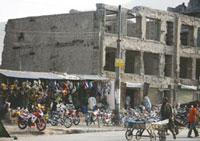 The dominating force was the sky, which without layers of smog and pollution was the most brilliant blue I have ever seen. We stopped for a photo opportunity and looked back at the road behind us, which snaked up the pass. Camouflaged old forts melded into the landscape and the extremely tall highly decorated trucks unique to this part of the world, called jinglis, were hauling massive logs from somewhere in the Himalayas. They never got out of first gear. Lumber for building and burning is at a premium in Afghanistan as most of the country looks like a moonscape with not a tree in sight.
The dominating force was the sky, which without layers of smog and pollution was the most brilliant blue I have ever seen. We stopped for a photo opportunity and looked back at the road behind us, which snaked up the pass. Camouflaged old forts melded into the landscape and the extremely tall highly decorated trucks unique to this part of the world, called jinglis, were hauling massive logs from somewhere in the Himalayas. They never got out of first gear. Lumber for building and burning is at a premium in Afghanistan as most of the country looks like a moonscape with not a tree in sight.
All along the Salang Pass are tunnels built by the Soviets. Most of them are a marvel of engineering but the jewel in the crown is surely the Salang Tunnel, which is almost at the end of our journey. All the tunnels on the road up the mountain had air gaps that let the light in but the Salang Tunnel is 3 kilometres of pitch black, amplified by 44 years of exhaust smut lining the road, walls and roof. Small lights resembling matches light the way but even they are absorbed by the blackness. The tunnel opened in 1964 and was an Afghanistan-Soviet Union joint venture that saved more than 300 kilometres in travel. The tunnel is about 7 metres high and wide and about 1000 vehicles use it each day.
The tunnel has a history as interesting as the rest of the country. During the Soviet-Afghan war, it was a crucial link for the military but was prone to ambushes by the Mujahideen. In 1982, a tanker truck exploded and the fire engulfed a military convoy, killing more than 2000 people.
In ’97-’98, the tunnel’s ventilation system was destroyed in a battle between the Northern Alliance and the Taliban and it wasn’t until 2002 that the tunnel reopened to traffic. But once again there were problems; an avalanche trapped several hundred people and many of them died of asphyxiation and cold. Further damage control and repairs restored the tunnel in 2004. Fortunately Karin and I were unaware of these finer details when we committed to the ride, otherwise we may have had a quiet Friday back at the lodgings.
Had we known all these facts, nothing would have prepared us for the blackness. The light from our headlights was just absorbed into the grease and grime. The road, walls and ceiling were coated in exhaust fumes and muck and while the others in our convoy may have felt “jaunty” in their open-faced, shiny, red Chinese bike helmets, this is where my bright yellow, full-face, balloon head accessory came into its own. I was blissfully in the dark, so much so that I hadn’t even realised we had exited out into the sunlight until the bike engine stopped.
After swivelling the helmet around and extracting my head, I noticed my companions were looking a bit pale. Frightened even, whereas I was like a mushroom, kept in the dark and as nothing untoward had happened in the previous five hours, I had total trust in my riding companion, though I did notice he looked a bit stressed.
Alighting from the bike was somewhat less elegant than the previous flat tyre incident. This time we all had a John Wayne gait; some even had a nervous tremor. The first thing we saw was a Soviet tank on it’s side down the side of the hill; the second was a “chai” (tea) shop that you entered by passing a frozen ice sculpture containing old plastic bags and rubbish. If you were to stretch the imagination, Damien Hirst could have got away with using it as an art installation at the Tate Gallery in London.
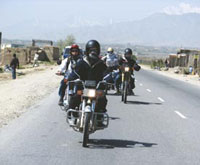 The most important thing was the heat coming from behind that wall, a Kilim on the floor, tea and other goodies that elicited a surge of excitement from this saddle-sore group. For half an hour we wandered about taking photographs of each other and the frozen surroundings until the inevitable “right, it’s time to head back” was called. The river was frozen, we were freezing and the scenery was amazing; even the huge power poles that carried billboards suggesting that the Afghan Wireless company kept people in contact didn’t seem like too much of a blight on the landscape.
The most important thing was the heat coming from behind that wall, a Kilim on the floor, tea and other goodies that elicited a surge of excitement from this saddle-sore group. For half an hour we wandered about taking photographs of each other and the frozen surroundings until the inevitable “right, it’s time to head back” was called. The river was frozen, we were freezing and the scenery was amazing; even the huge power poles that carried billboards suggesting that the Afghan Wireless company kept people in contact didn’t seem like too much of a blight on the landscape.
However, the thought of another five hours backtracking along the same route had lost some of its thrill-seeking qualities. Karin and I posed in front of the tunnel exit, under a picture of Ahmad Shah Massoud, Afghanistan’s martyred hero, quietly relieved that all had gone so well. By now I had worked out that if I wrapped my blanket cum headscarf in a particular way around my head, my extra large, luminous yellow helmet might stay in place. In fact, the wrapping was so good that this time the helmet was wedged on my head and all the excitement of the pitch black tunnel was there for me to enjoy.
I realised that my driver was an expert who could challenge any dirt bike champion on the planet. We were also grateful that the Kabul Knights had gotten us out of the city and given us an experience that still resonates with us.
The overpowering memory is that I still don’t know what side of the road they drive on in Afghanistan – other than the one that has some space.
Marianne Harris
